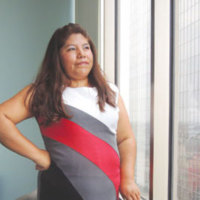
Santiago
There are an estimated 403,000 people living in conditions of modern slavery in the United States (GSI 2018). The US attracts migrants and refugees who are particularly at risk of vulnerability to human trafficking. Trafficking victims often responding to fraudulent offers of employment in the US migrate willingly and are subsequently subjected to conditions of involuntary servitude in industries such as forced labour and commercial sexual exploitation. Santiago travelled from Mexico to the United States and was trafficked into forced labour in California when he was 21 years old. Without papers, Santiago was vulnerable. When he asked his employer for his salary, she called immigration and had him deported, then arranged for him to cross back and then kept him in debt bondage for the expenses of his journey.

Nena
There are an estimated 403,000 people living in conditions of modern slavery in the United States (GSI 2018). The US attracts migrants and refugees who are particularly at risk of vulnerability to human trafficking. Trafficking victims often responding to fraudulent offers of employment in the US migrate willingly and are subsequently subjected to conditions of involuntary servitude in industries such as forced labour and commercial sexual exploitation. Nena was trafficked into domestic servitude at the age of 55. She had already retired from her teaching job in the Philippines and thought going to the United States would be a good opportunity to financially help her family.

Fedelina
There are an estimated 403,000 people living in conditions of modern slavery in the United States (GSI 2018). The US attracts migrants and refugees who are particularly at risk of vulnerability to human trafficking. Trafficking victims often responding to fraudulent offers of employment in the US migrate willingly and are subsequently subjected to conditions of involuntary servitude in industries such as forced labour and commercial sexual exploitation. Fedelina moved to the U.S from the Philippines for domestic work in 1974. She was told she would be looking after just one person, but upon arrival found she was to work for the entire family across multiple households. She was forced to wake up at 4.30am each morning to cook, clean and care for the family’s children. Her movement was restricted, and she was forced to sleep on the floor of her employer’s house, despite there being three bedrooms. One day in 2018, when Fedelina’s employer was receiving dialysis, the Filippino nurse treating her called an ambulance after Fedelina became sick. Though Fedelina told the hospital that she was paid for her work and free to leave at any time, later the FBI showed up and assisted in her in leaving her exploitation.

Jayson De Guzman
There are an estimated 403,000 people living in conditions of modern slavery in the United States (GSI 2018). The US attracts migrants and refugees who are particularly at risk of vulnerability to human trafficking. Trafficking victims often responding to fraudulent offers of employment in the US migrate willingly and are subsequently subjected to conditions of involuntary servitude in industries such as forced labour and commercial sexual exploitation. Jayson De Guzman was working in construction in the Philippines when he came into contact with a woman who offered him work in the United States on a P-1 visa. Upon arrival in the US, Jayson was met by this same woman who took his passport and told him he owed her $12,000 and would have to work for her for 10 years to pay off his debt. De Guzman was forced to work in the same elderly care facility as Angela Guanzon who had been trafficked from the Philippines by the same recruiter. Jayson was forced to work seven days a week, twenty-four hours a day with breaks only for sleep. The majority of his salary was taken by the recruitment as ‘repayment’ for his debts. Jayson De Guzman was finally able to escape his situation when a neighbour of the facility noticed the workers were not getting any days off and called the FBI.

Flor (Narrative 2)
Flor was trafficked into the US from Mexico and enslaved in forced factory labour. She travelled into the US willingly with a “coyote,” or people smuggler, after being offered well-paid work in the US. Instead of the job promised, she was kept prisoner and abused, working extremely long hours. She told her story to another survivor, Ima. Both women were part of the Survivor Advisory Caucus attached to the Coalition Against Slavery and Trafficking in Los Angeles (CAST LA). Flor talks about her the pride and satisfaction that working with Ima as part of the Caucus has brought her. Another narrative from Flor can be found in the archive.